Greenhouse merry-go-round
Those of you new to reading this blog may not know that I built my dream greenhouse this year. It’s a major extravagance and something I’ve saved up for. I have long been drawn to exotic plants and tender species so the greenhouse contains a small annexed area which can be heated. This week, with cold forecast I set about moving plants into and around the greenhouse to make sure they’d survive.
This was great fun, especially arranging an attractive display in the heated zone. I was in my element – but I had an important decision to make – what temperature to maintain the heated zone at?
Research was required so I made a list of all the plants I have collected or grown from seed this year and looked up their minimum temperature requirements. Some are pretty hardy, coping with zero degrees, whereas my Papaya and Calathea prefer the balmy heights of 13 degrees. Looking at the list I decided that the optimum temperature for this zone is around 10 degrees. So far the Calathea and Papaya seem to have coped when the temperature dips below 10 but I’m ready to move them to the house if necessary.
I’ve been experimenting with settings on the heater as whilst it’s thermostatically controlled, some element of trial and error is required. Night temperatures are one thing – but during the day, if the sun shines, it’s glorious sitting in my deck-chair in the greenhouse and enjoying a cup of tea.
Dahlia black-out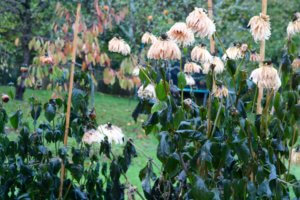
There was a very heavy frost overnight on Tuesday and I awoke on Halloween to blackened dahlias, an inevitable but rather depressing sight. The soggy leaves and downturned heads rather upset me. Most I will leave in the ground as they appear to cope well overwinter here under a thick duvet of mulch. But my ‘Cafe Au Lait’ were too tall for where I planted them and some others were in temporary locations, so I’m digging a few up and storing the tuburs.
This is very easy to do, if a little time consuming. You wash off the soil and turn the tuburs upside down for a day or two, balancing them on their cut stalks to make sure they dry out underneath. Then I either bury them in a box of dryish compost, or as I have done in the past, hang them from onion sacks in the rafters of a dry, frost free shed to stop the mice getting at them. Here’s a picture from a few years ago when I lifted every dahlia. This year there’ll only be a few, which is a relief. It’s time-consuming to do this and I need time in my greenhouse for my tea-drinking.
Glowing Acer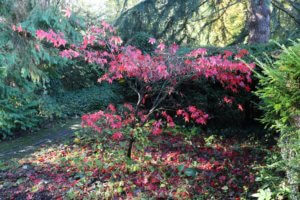
This acer is growing in completely the wrong place as I cannot see it tucked away at the far end of the garden, behind a tall yew hedge. This week I caught a glimpse of bright maroon and guiltily remembered what it was.
It’s a glorious tree. Up close I noticed the winged seeds on it but cannot remember seeing any flowers. There must have been something though – does anyone know what they look like?
They say you shouldn’t hide your light under a bushel. I shouldn’t hide my acer behind a bush.
Iris seedhead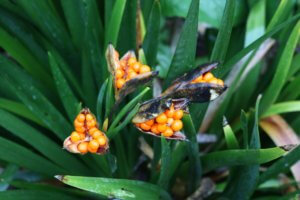
I’m watching these stunning Iris seed-heads carefully. They developed on a plant that I cannot remember planting . Having looked it up I thoght it might be one called Iris x pacifica ‘Broadleigh Rose’. Now I’ve seen that the seeds look like glowing run-way beacons, I can’t help thinking their ‘eat-me’ orange look may be noticed by birds flying overhead. If they do get consumed by birds I may have discovered how the plant arrived in my garden in the first place…
Banksian Medal
This week was a proud one for me as I was asked to join the committee of my local Horticultural Society and was elected at the AGM on Thursday night. I have come to enjoy my nights at the “horti” and we are lucky to have a lively calendar of great speakers. I’m looking forward to getting more involved behind the scenes.
The format this week was different. Set up like a television chat-show, the stage was set for our 90 year old Vice-president to be interviewed. An incredible gardener in her own right, she was the winner of many a trophy. The daughter of one of the original members of our Society, a local head gardener, I learned that it has been going since 1930. She shared photos and reminiscences and moved us all greatly.
Also taking place that night was an award of something called a Banksian Medal. As a fairly new member of the Society I was unaware that this prize existed for the most points won overall in our Spring and Autumn shows. One medal is donated by the RHS to every affiliated society each year and is named after Joseph Banks, the 18th Century botanist.
I was very happy to find out that I’d won – by 1 point. Having seen our 90 year old member’s photos of some of the incredible entries in shows of yester-year, I felt a bit of a fraud and it’s clear that the volume of entries is down compared to years ago. There’s something about showing though that has made me a better gardener and bringing a medal home was lovely. My son ran off upstairs and brought down his collection of sports trophies to show he still had more than me!
I’ve written an article here on showing, so if any readers are tempted next year you can start planning over the winter.
War Gardens
The Six on Saturday community shares one thing – an unshakeable passion for plants. Would your passion be shaken in a war zone? Do you know if or how you’d garden with rockets falling around you? I recently went to a talk at the Garden Museum in London at which the author of this book spoke about her experiences of meeting gardeners in war zones of Afghanistan, the Ukraine and the Middle East.
Lalage (Lally) Snow’s story alone in intriguing. Heading to Afghanistan as a self-funded, freelance, student photo-journalist in her early twenties seems to me an astoundingly brave decision.
The people she meets are braver yet. As she says – she could always escape and return to England if things got too much. The gardeners she met are trapped, some in Gaza and Palestinian West Bank enclaves, some behind tight security in Israeli settlements and Kibbutzim, some in the continuing Civil War in the Donbass. Yet they grow fruit, flowers, vegetables and some even bonsai and cacti. The joy is not just in growing food – often it’s the growing of ornamental flowers that brings the peace and fulfilment otherwise lacking in their daily lives.
Her words and photographs are powerful and thought-provoking. Lally gave me permission to use her photos in my book review, which you can read here.
If you’re looking for reading matter over the winter, take a break from your seed catalogues and give this a try.
Six on Saturday is a weekly meme – take a look at the comments at the base of host The Propagator to see more ‘sixes’ from other keen gardeners from all over the world.


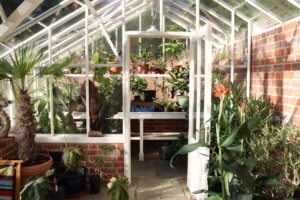
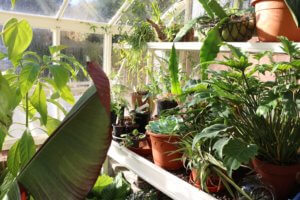
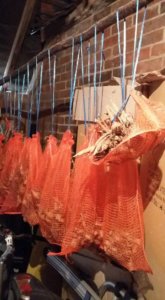
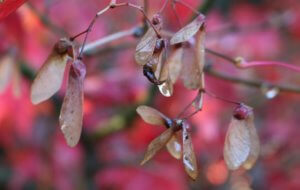
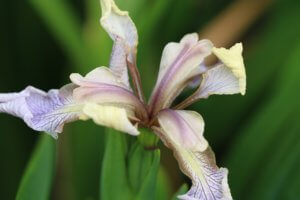
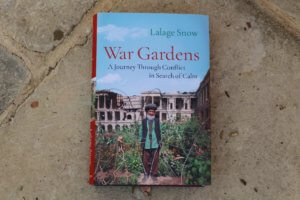
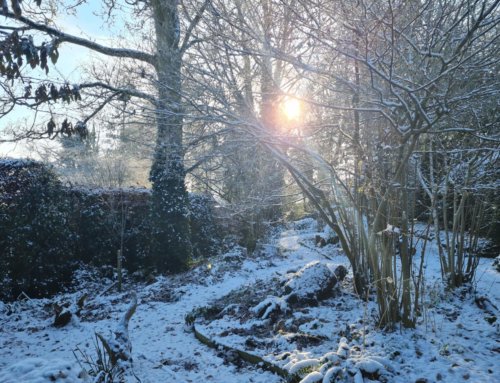
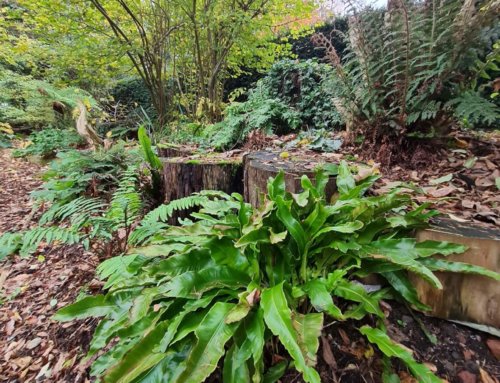
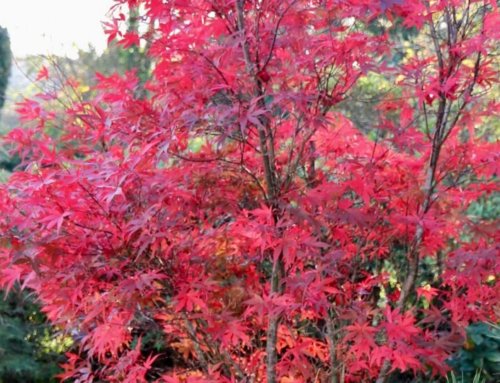
I’ve never seen an iris seed head before. Very unusal looking. Love the greenhouse and the autumn colour of the acer. Congratulations on the medal.
Thanks Graeme, that seedhead certainly likes to be noticed doesn’t it!
The thing I envy most about your lovely greenhouse is what you don’t have, which is so many plants there’s no room to sit it in it. That’ll change of course. I’m slightly puzzled how if you didn’t plant it, you’ve identified your Iris as ‘Broadleigh Rose’. I’d have said it was Iris foetidissima but I feel under qualified and a bit rude to even mention it.
Hi Jim, Not rude at all. That’s what’s great about online gardening – shared knowledge. The thing about the Iris was that I was scratching my head a bit in the garden when I spotted it, then saw one just like it on twitter and thought – bingo! If it was a bird drop then it’s possible it isn’t what I thought it was. Will look up Iris foetidissima now. You’re right about the greenhouse – in a couple of years you’ll find an origami tea break gardener folded up in a tiny corner surrounded by plants!
I am very interested in your winter experience of your greenhouse. From your good (and bad) results, I will be tempted to buy a heater as I have said before. Your greenhouse is bigger and your plants more exotic (papaya!😍) but I’m sure Your solution will be mine !😁
I’m feeling the pressure now Fred! So far so good with the heater but I’ll keep you informed. The Papaya was an odd purchase – it was sold in a UK supermarket called Asda. I wonder how many people bought one this summer not knowing how to overwinter it. Hopefully they’ll realise they need to bring them indoors…
I’m so envious of your lovely greenhouse and swear that one day, I shall have my own – maybe I shall write novels in it!
I’ve actually noted the War Gardens book- it sounds truly fascinating. I wonder if it is the particular comfort that one gains by gardening. I’m sure we’d all agree that gardening anchors us, it’s meditative and mindful and take us away from angst. I always used to joke that as political idiots ruin the world around us, I am just going to go into the garden and grow veggies! Maybe not such a joke after all…
Hi Prue – yes novel writing in a greenhouse would be lovely! One of the people Lalage Snow met in Afghanistan for her War Gardens book was a student and he had a desk in the corner to study at, surrounded by Pelargoniums and Begonias.
Congratulations on your medal, it seems well deserved from my viewpoint. Enjoy your Autumn tea breaks in the balminess of your magnificent greenhouse!
I am also envious of your gorgeous greenhouse. I would love to grow more tender and exotic plants, but haven’t the room for a greenhouse here and it would be far too expensive to heat the conservatory/orangery. I will just have to stick with those that can tolerate the cold, if not the frost and snow. As for the iris I’d be inclined to go with Jim and the Iris foetidissima which can be found in the wild.
Hi Jude – I’ve looked up Iris foetidissima and I think you and Jim are both right. I think I may even have seen some in the woods round here so makes it even more likely. Silly me for thinking it was a hybrid but it did look so like one I saw on social media.
At the risk of sounding like a scratched record now, i so covet your beautiful greenhouse. It is a thing of beauty. My favourite of your six though is the iris seedheads. They look quite alien dont they? I have some iris in the garden now, perhaps i will get seeds next year.
I keep taunting you with greenhouse pics, I know!
The Iris seedheads really do glow – they’re a bit like tint Halloween lanterns.
Your greenhouse is so very smart and must be a joy to work and drink tea in! The War Gardens book sounds utterly fascinating and I shall try to source it. We don’t know how lucky we are as we only have the weather to complain about with our gardens. Your Acer might be in the wrong place, but it looks gorgeous with all those darker colours around it. And congratulations on the medal…well done!
Hi Jane, I hope you do read the War Gardens book. As I say it’s obviously not an easy read but I found it really resonated with my sentiments as a gardener.
I imagine there’d be a bit of necessity to gardening in a war zone, as well as all the other benefits. What hope you’d have to have to do it, whatever the reason. Puts things into perspective. And to think this week I was grousing about the postie guy being annoyed over my Halloween decorations.
Yes, that perspective is so important isn’t it.
Wonderfully diverse Six. The greenhouse is so incredible I am torn between the green-eyed monster and respect for your hard work to achieve it. Blackened dahlias are a milestone in the year, same for the acer. Well done for your new role, I am sure you will find it very fulfilling/challenging. As for the book, fabulous, something we should dwell on once in a while, especially on those moany days when nothing seems to go right. Thanks 🙂
Ah, thanks Gill. Yes it’s important to read books like this once in a while to put our lives in perspective. On the greenhouse – it’s been so much fun that it doesn’t feel like hard work. I love being in there tinkering and moving things about.
Lovely post!
Thanks Barbara.
Whilst a very amateur gardener, I very much enjoy your well written and informative writing. Thank you for brightening my day, you write in a way which makes me feel like I am listening to a close friend chatting over a cup of tea.